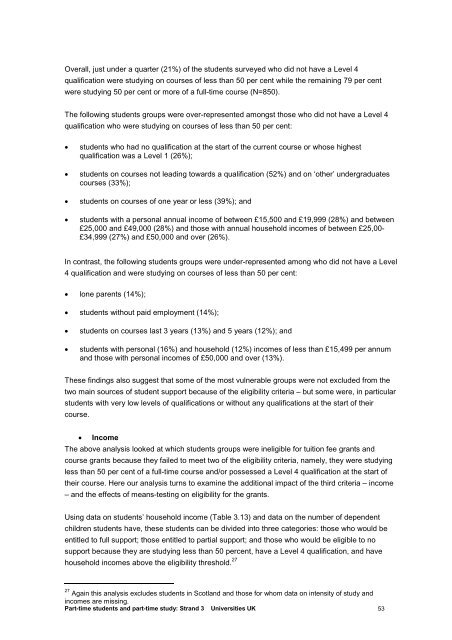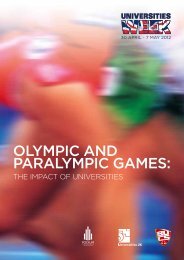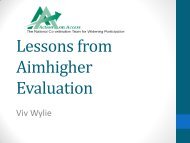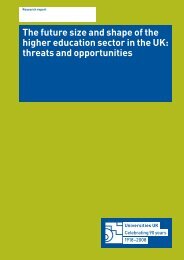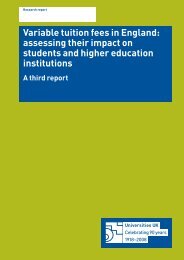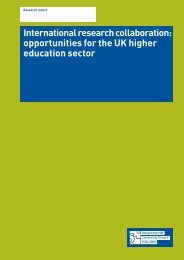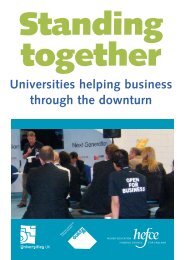Part-time Students And part-time Study In Higher ... - Universities UK
Part-time Students And part-time Study In Higher ... - Universities UK
Part-time Students And part-time Study In Higher ... - Universities UK
You also want an ePaper? Increase the reach of your titles
YUMPU automatically turns print PDFs into web optimized ePapers that Google loves.
Overall, just under a quarter (21%) of the students surveyed who did not have a Level 4qualification were studying on courses of less than 50 per cent while the remaining 79 per centwere studying 50 per cent or more of a full-<strong>time</strong> course (N=850).The following students groups were over-represented amongst those who did not have a Level 4qualification who were studying on courses of less than 50 per cent:• students who had no qualification at the start of the current course or whose highestqualification was a Level 1 (26%);• students on courses not leading towards a qualification (52%) and on ‘other’ undergraduatescourses (33%);• students on courses of one year or less (39%); and• students with a personal annual income of between £15,500 and £19,999 (28%) and between£25,000 and £49,000 (28%) and those with annual household incomes of between £25,00-£34,999 (27%) and £50,000 and over (26%).<strong>In</strong> contrast, the following students groups were under-represented among who did not have a Level4 qualification and were studying on courses of less than 50 per cent:• lone parents (14%);• students without paid employment (14%);• students on courses last 3 years (13%) and 5 years (12%); and• students with personal (16%) and household (12%) incomes of less than £15,499 per annumand those with personal incomes of £50,000 and over (13%).These findings also suggest that some of the most vulnerable groups were not excluded from thetwo main sources of student support because of the eligibility criteria – but some were, in <strong>part</strong>icularstudents with very low levels of qualifications or without any qualifications at the start of theircourse.• <strong>In</strong>comeThe above analysis looked at which students groups were ineligible for tuition fee grants andcourse grants because they failed to meet two of the eligibility criteria, namely, they were studyingless than 50 per cent of a full-<strong>time</strong> course and/or possessed a Level 4 qualification at the start oftheir course. Here our analysis turns to examine the additional impact of the third criteria – income– and the effects of means-testing on eligibility for the grants.Using data on students’ household income (Table 3.13) and data on the number of dependentchildren students have, these students can be divided into three categories: those who would beentitled to full support; those entitled to <strong>part</strong>ial support; and those who would be eligible to nosupport because they are studying less than 50 percent, have a Level 4 qualification, and havehousehold incomes above the eligibility threshold. 2727 Again this analysis excludes students in Scotland and those for whom data on intensity of study andincomes are missing.<strong>Part</strong>-<strong>time</strong> students and <strong>part</strong>-<strong>time</strong> study: Strand 3 <strong>Universities</strong> <strong>UK</strong> 53


